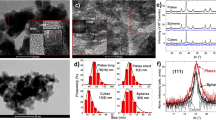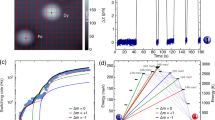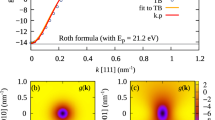Abstract
The original magnetic properties of nanometre-sized particles are due to the distinct contributions of volume, surface and step atoms. To disentangle these contributions is an ongoing challenge of materials science. Here we introduce a method enabling the identification of the remarkably different contributions of surface and perimeter atoms to the magnetic anisotropy energy of two-dimensional nanostructures. Our method uses the generally nonlinear relationship between perimeter length and surface area. Atomic-scale characterization of the morphology of ensembles of polydisperse nanostructures, combined with in situ measurements of their temperature-dependent magnetic susceptibility, gives access to the role played by the differently coordinated atoms. We show for Co nanostructures on a Pt(111) surface that their uniaxial out-of-plane magnetization is entirely caused by edge atoms having 20 times more anisotropy energy than their bulk and surface counterparts. Identification of the role of perimeter and surface atoms opens up unprecedented opportunities for materials engineering. As an example, we separately tune magnetic hardness and moment in bimetallic core–shell nanostructures.
This is a preview of subscription content, access via your institution
Access options
Subscribe to this journal
Receive 12 print issues and online access
$259.00 per year
only $21.58 per issue
Buy this article
- Purchase on Springer Link
- Instant access to full article PDF
Prices may be subject to local taxes which are calculated during checkout





Similar content being viewed by others
References
Chou, S.Y. Patterned magnetic nanostructures and quantized magnetic disks. IEEE Proc. 85, 652–671 ( 1997).
Harris, J. & Awschalom, D. Thin films squeeze out domains. Phys. World 19–20 ( Jan, 1999).
Albrecht, M., Rettner, C.T., Moser, A., Best, M.E. & Terris, B.D. Recording performance of high-density patterned perpendicular magnetic media. Appl. Phys. Lett. 81, 2875–2877 ( 2002).
Plumer, M.L., Ek, J.v. & Weller, D. (eds) The Physics of Ultra-High-Density Magnetic Recording (Springer, Berlin, 2001).
Woods, S.I., Kirtley, J.R., Sun, S. & Koch, R.H. Direct investigation of superparamagnetism on Co nanoparticles films. Phys. Rev. Lett. 87, 137205 ( 2001).
Petit, C., Taleb, A. & Pileni, M.P. Self-organization of magnetic nanosized cobalt particles. Adv. Mater. 10, 259–261 ( 1998).
Puntes, V.F., Krishnan, K.M. & Alivisatos, P. Synthesis, self-assembly, and magnetic behavior of a two-dimensional superlattice of single-crystal ε-Co particles. Appl. Phys. Lett. 78, 2187–2189 ( 2001).
Sun, S., Murray, C.B., Weller, D., Folks, L. & Moser, A. Monodisperse FePt nanoparticles and ferromagnetic FePt nanocrystal superlattices. Science 287, 1989–1992 ( 2000).
Jamet, M. et al. Magnetic anisotropy of a single cobalt nanocluster. Phys. Rev. Lett. 86, 4676–4679 ( 2001).
Held, G.A., Grinstein, G., Doyle, H., Sun, S. & Murray, C.B. Competing interactions in dispersions of superparamagnetic nanoparticles. Phys. Rev. B 64, 012408 ( 2001).
Black, C.T., Murray, C.B., Sandstrom, R.L. & Sun, S. Spin-dependent tunneling in self-assembled cobalt-nanocrystal superlattices. Science 290, 1131–1134 ( 2000).
Fruchart, O. et al. Vertical self-organization of epitaxial magnetic nanostructures. J. Magn. Magn. Mater. 239, 224–227 ( 2002).
Brune, H., Giovannini, M., Bromann, K. & Kern, K. Self-organized growth of nanostructure arrays on strain-relief patterns. Nature 394, 451–453 ( 1998).
Repain, V., Baudot, G., Ellmer, H. & Rousset, S. Two-dimensional long-range-ordered growth of uniform cobalt nanostructures on a Au(111) vicinal template. Europhys. Lett. 58, 730–736 ( 2002).
Brune, H., Romainczyk, C., Röder, H. & Kern, K. Mechanism of the transition from fractal to dendritic growth of surface aggregates. Nature 369, 469–471 ( 1994).
Wernsdorfer, W. et al. Experimental evidence of the Néel-Brown model of magnetization reversal. Phys. Rev. Lett. 78, 1791–1794 ( 1997)
Kinzel, W. & Fischer, K.H. Dynamics of spin glasses. Solid State Commun. 23, 687–690 ( 1977).
Koide, T. et al. Direct Determination of interfacial magnetic moments with a magnetic phase transition in Co nanoclusters on Au(111). Phys. Rev. Lett. 87, 257201 ( 2001).
Wu, R., Li, C. & Freeman, A.J. Structural, electronic and magnetic properties of Co/Pd(111) and Co/Pt(111). J. Magn. Magn. Mater. 99, 71–80 ( 1991).
Nakajima, N. et al. Perpendicular magnetic anisotropy caused by interfacial hybridization via enhanced orbital moment in Co/Pt multilayers: magnetic circular x-ray dichroism study. Phys. Rev. Lett. 81, 5229–5232 ( 1998).
Ferrer, S. et al. Surface X-ray diffraction from Co/Pt(111) ultrathin films and alloys: Structure and magnetism. Phys. Rev. B 56, 9848–9857 ( 1997).
Aharoni, A. Demagnetizing factors for rectangular ferromagnetic prisms. J. Appl. Phys. 83, 3432–3434 ( 1998).
Gambardella, P. et al. Ferromagnetism in one-dimensional monatomic metal chains. Nature 416, 301–304 ( 2002).
Chantrell, R.W., Walmsley, N., Gore, J. & Maylin, M. Calculations of the susceptibility of interacting superparamagnetic particles. Phys. Rev. B 63, 024410 ( 2000).
Haginoya, C. et al. Magnetic nanoparticle array with perpendicular crystal magnetic anisotropy. J. Appl. Phys. 85, 8327–8331 ( 1999).
Weber, W., Back, C.H., Bischof, A., Pescia, D. & Allenspach, R. Magnetic switching in cobalt films by adsorption of copper. Nature 374, 788–790 ( 1995).
Dürr, H.A. et al. Spin and orbital magnetization in self-assembled Co clusters on Au(111). Phys. Rev. B 59, R701–R704 ( 1999).
Ohresser, P., Brookes, N.B., Padovani, S., Scheurer, F. & Bulou, H. Magnetism of small Fe clusters on Au(111) studied by x-ray magnetic circular dichroism. Phys. Rev. B 64, 104429 ( 2001).
Acknowledgements
We gratefully acknowledge the contribution of A. Barraud and financial support from Top-Nano-21 and from the Swiss National Science Foundation.
Author information
Authors and Affiliations
Corresponding author
Ethics declarations
Competing interests
The authors declare no competing financial interests.
Rights and permissions
About this article
Cite this article
Rusponi, S., Cren, T., Weiss, N. et al. The remarkable difference between surface and step atoms in the magnetic anisotropy of two-dimensional nanostructures. Nature Mater 2, 546–551 (2003). https://doi.org/10.1038/nmat930
Received:
Accepted:
Published:
Issue Date:
DOI: https://doi.org/10.1038/nmat930
This article is cited by
-
Effects of Cobalt Nanoisland Geometry on Terahertz Negative Refraction: a Numerical Analysis
Journal of Superconductivity and Novel Magnetism (2021)
-
Size effect in graphene nano-islands: A Monte Carlo study
Journal of Computational Electronics (2017)
-
Control of single-spin magnetic anisotropy by exchange coupling
Nature Nanotechnology (2014)
-
Complex magnetic structure of clusters and chains of Ni and Fe on Pt(111)
Scientific Reports (2013)
-
Stabilizing the magnetic moment of single holmium atoms by symmetry
Nature (2013)



